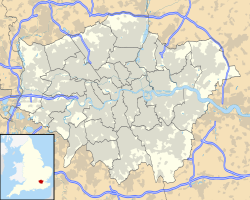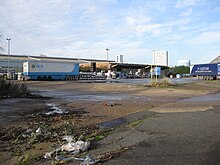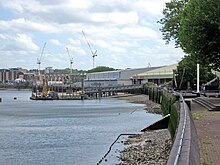Convoys Wharf
Location of Convoys Wharf in Greater London |

The Convoys Wharf , formerly King's Yard called, housed the shipyard Deptford , the first of the shipyards of the Royal Navy on the River Thames in London . It was opened in 1513 by Henry VIII to build ships for the Royal Navy. Convoys Wharf also includes the largest part of the property of the manor Sayes Court , including its gardens, home of diarist John Evelyn . The site belonged to News International until 2008 , which imported newspapers and paper goods from Finland until 2000 . Today it belongs to Hutchison Whampoa and a building application has been made to convert it into a residential area, even though it is a Safeguarded Wharf (port facility with historical protection of existing property).
history
The King's Yard was opened by Henry VIII in 1513 as the first shipyard of the Royal Navy and was the leading shipyard of its time. He made for an increase in the population and an increased standard of living in Deptford.
The docks are also linked to the accolade of Sir Francis Drake by Queen Elizabeth I on board the Golden Hinde , further to the legend of Sir Walter Raleigh , who laid down his overcoat for Queen Elizabeth, Captain James Cook's third voyage on board the Resolution , Frobishers and Vancouver's expeditions in which ships were used against the Spanish Armada and with Nelson's battles, such as B. that of Trafalgar .
In 1698 Peter I of Russia , then 25 years old, came to Deptford to learn the craft of shipbuilding and seaman. King Wilhelm III. Allowed him to live in John Evelyn's Sayes Court next to the shipyard. During the three months he and his entourage did considerable damage to the famous gardens and the house, "most of the furniture was broken, disappeared or destroyed." Sir Christopher Wren was in charge of monitoring the property and stated that it had been "completely destroyed". At the mouth of Deptford Creek , on the property of Fairview Housing , there is a statue made by Mihail Chemiakin , donated by Russia to commemorate Peter's visit.
In the 18th century, because of the silting up of the Thames, the use of the port facilities was limited to the building of ships and the distribution of materials to other ports and fleets operating abroad. From 1830 to 1844 Convoys Wharf was even closed completely and in 1864 a parliamentary commission called for the shipyards in Deptford and Woolwich to be closed for good. Their recommendation was accepted and the Deptford shipyard finally closed in 1869; at that time 800 workers were employed there. A total of around 450 ships were built there, the last being the wooden corvette HMS Druid , which was launched in 1869.
Before refrigeration was invented , calves had to be imported alive and the Contagious Deseases (Animals) Act of 1869 gave the City of London Corporation the sole right to import and process animals from abroad , whereby she was bound to open a market by January 1872. The site in Deptford was bought, a market opened in 1871 and expanded to 109,265 m² by 1889. In its prime, 1907, 184,971 calves and 49,350 sheep were traded there, but by 1912 those numbers had fallen to 21,547 calves and 11,993 sheep.
The butchers in the slaughterhouses and the girls who worked the joints of the animals became typical of the area. In particular, the "Gut Girls" were not only known for their rude language and their rough handling, including the wild booze, but also for their colorful hats. Her weekend behavior became known all over London. Girls working in the West End of London switched en masse to the high paying jobs in the market. This fact, perhaps even more than their notorious behavior, led to the establishment of a “rescue mission”. Their building, the Lady Florence Institute , can still be seen on Deptford Broadway today.
In 1914, the Department of Defense leased the calf market to the City of London Corporation. Often after the armistice , traders and other people would demand that the market be reopened, but in 1924 the Department of Defense made use of its option to purchase the property.
The shipyard served as an army depot during the First and Second World Wars and also as a US base for amphibious vehicles and the like during World War II.
Most of the structures that survived through the Tudor, Stuarts, Georgian and Victorian eras and survived until 1955 have since been demolished. The only structure that escaped destruction is the Olympia Warehouse, a unique cast iron building that originated in the 1840s. Excavations carried out by CgMs, by Duncan Hawkins in 2000, by Jon Lowe in the same year, and by David Divers in 2001 indicated that most of the shipyard survived as underground structures that were backfilled between 1869 and 1950. The structures of the shipyard itself, the docks, the slips, the basins, the ponds, the moorings and the stairs form a lot of archaeological material that is currently extensive, although largely invisible because it is covered with excavated material or modern buildings. To date, no archaeological investigations have been carried out in the garden of Sayes Court, only a few trenches have been dug in the area of the former manor house.
The site lay fallow until it was bought by the newspaper importer Convoys in 1984. The Convoys Wharf and Deptford shipyards and port, as well as the Convoys company , were bought by News of the World in 1990 and became part of the News International group. Nevertheless, at the peak in the mid-1990s, only about 10% of Convoy's newspaper imports were passed on to the parent company. At the beginning of the 1990s, the tonnages rose steadily and they reached almost 1 million tons per year. At the end of the 1990s, a ban on truck traffic was introduced in Greenwich (Greenwich Lorry Ban) and significantly increased the time and cost of transporting paper from the Convoys Wharf to the delivery points, so that trade moved to Felixstowe and Chatham .
In 1993 the area was no longer assigned to Greenwich by law , but to Lewisham .
Planning application
In 2002 News International applied to the London Borough of Lewisham for planning permission to build 3,500 residential units on the site. The Lewisham district administration issued the permit in May 2005. In July 2008, however, the permit still had to be signed by the Mayor of London , Boris Johnson . The mayor can and presumably will order a rejection.
If the mayor approves the proposal, it will be presented to the Secretary of State for Communities and Local Government . The reasons for this lecture also lie in a government directive that half of the site would be protected as an industrial monument. Since port facilities on the Thames were protected as industrial monuments by Secretary of State for the Environment John Gummer in 1997 , only one operating port facility has been lost to a residential area without public investigation. This was Delta / Blackwall Wharf, a port facility that was rebuilt as part of the Greenwich Peninsula master plan.
On May 18, 2005, a joint venture company with equal shares for Cheung Kong Holdings and Hutchison Whampoa undertook to buy Convoys Wharf and develop it into a mixed residential / commercial area.
In 2008, Hutchinson Whampoa purchased 16 hectares from News International and in November 2009 they re-submitted plans for the £ 700 million construction of 3,500 units. The plans included minor changes from the Richard Rogers Partnership's 2005 master plan , although Hutchison Whampoa bought Aedas to replace Rogers.
The Olympic warehouse, which is listed as a Grade II building worth preserving, must be preserved and restored as part of the renovation.
protest
In October 2000, formed Creekside Forum a Convoys Wharf - governing body in response to the plans of News International Ltd., the 161,874 square meter Convoys Wharf premises to sell. The Convoys Community, made up of community organizations, churches, businesses and others in Deptford and beyond, campaigned to reject News International's plans and instead stick to protecting the site as an industrial monument.
London is one of the few cities that does not have a specially built cruise ship terminal despite the water depth. If the application goes through with Mayor Boris Johnson, Convoys Opportunity will ask Hazel Blears to refer the application (after a public inquiry) to the Minister for decision.
Web links
- Shipwright's Palace, a weblog dedicated to Historic Maritime Deptford and related topics .
- Website about the development of Convoys Wharf
- Creekside Forum News
- Lewisham Unitary Development Plan 2004, Schedule 3 - Areas of Archaeological Priority protected by Policy URB 21 Archeology and shown on the Proposals Map (English)
- Objections to planning application for Convoys Wharf , Tenants Action Group, Pepys - TAG (English)
- No more penthouses , News Shopper, Lewisham & Greenwich, May 17, 2005 (English)
- New look for old wharf , News Shopper, Lewisham & Greenwich, May 31, 2005
- Include tribute in wharf scheme , News Shopper, Lewisham & Greenwich, 19 July 2005 (English)
- GLIAS Convoys Wharf, Deptford , Notes and news, December 2009 (English)
- Greenwich History: Proposed List of Remnants at the Royal Navy Deptford Shipyard, Jan 6, 2010
- Safeguarded Wharves , 2005 official list and descriptions (PDF; 6.6 MB)
- Naval Dockyards Society website
literature
- Duncan Hawkins: An archaeological desk-based assessment . CgMs Consulting. April 2000
- Jon Lowe: Preliminary Assessment of Surviving Historic Fabric Convoy's Wharf, Deptford . June 2000
- David Divers: Convoys Wharf, Deptford; TQ 3700 7820 . Evaluation October 9–14. November 2000. CgMs Consulting. for News International plc. CVW00
- David Divers: An archaeological field evaluation (trial trenching) in consultation with English Heritage . CgMs Ltd. January 2001
- Our Future Heritage: A Framework for the Management of The Heritage Resource, Convoys Wharf, Deptford, London Borough of Lewisham . English Heritage. October 2003
- London Snoring: A tale of missed opportunity . Creekside Forum. Spring 2007 (PDF; 73 kB)
Individual evidence
- ↑ Samuel Pepy's diary entry for August 22, 1665 (English)
- ↑ Evelyn's plan from 1653 overlaid with a modern road map ( memento of the original from January 20, 2012 in the Internet Archive ) Info: The archive link was inserted automatically and has not yet been checked. Please check the original and archive link according to the instructions and then remove this notice.
- ↑ Rogers Stirk Harbor + Partners "Convoys Wharf Conception" (English) ( Memento of the original from October 3, 2009 in the Internet Archive ) Info: The archive link was inserted automatically and has not yet been checked. Please check the original and archive link according to the instructions and then remove this notice.
- ↑ Saveguarded Wharves , Mayor's Office of London (English) ( Memento of the original dated August 30, 2012 in the Internet Archive ) Info: The archive link was inserted automatically and has not yet been checked. Please check the original and archive link according to the instructions and then remove this notice. (PDF; 6.6 MB)
- ↑ a b National Maritime Museum Research, Volume No. B5: Royal Naval Dockyards (English) ( Memento of the original from June 1, 2010 in the Internet Archive ) Info: The archive link was inserted automatically and has not yet been checked. Please check the original and archive link according to the instructions and then remove this notice.
- ↑ Deptford and Woolwich: London's Royal Dockyards - The working Thames - Port Cities , at portcities.org.uk (English)
- ↑ a b c london-footprints.co.uk shipyard in Deptford (English)
- ^ Yale H. Kelsey: Sir Francis Drake: The Queen's Pirate . H Kelsey, Yale University Press (Sep 1, 2000), pp. 218-219, ISBN 0-300-08463-3
- ^ Sir Walter Raleigh and the Quest for El Dorado . P. 83 and 176. Marc Aronson, Clarion Books (April 17, 2000), ISBN 0-395-84827-X
- ↑ Captain James Cook , pp. 273-294, Richard Hough, WWNorton (August 17, 1996), ISBN 0-393-31519-3
- ^ Deptford and the Armada by Thankful Sturdee The Times, September 3, 1888. p. 10, column. B.
- ↑ a b c Proposal for a list of the remains at the Royal Navy Shipyard at Deptford, Greenwich Industrial History, January 6, 2010
- ^ Deptford, St Nicholas, The Environs of London : Volume 4: Counties of Herts, Essex & Kent (1796) by Daniel Lysons, pp. 359-385
- ↑ The Charm of Sayes Court, John Evelyn as Garden Architect by WG Hiscock, The Times, August 11, 1952 page 2, column E
- ↑ Calender of Treasury Books, 1697-1702, pp. 158-159
- ↑ James Thorne, John Murray, Albemarle Street: Handbook of the Environs of London , 1876
- ^ A b Sale of Deptford Market. Government to Pay £ 387,000. , The Times, Mar 13, 2006, p. 12, column F.
- ^ Greater London Industrial Archeology Society, Notes and News - June 2002
- ^ Future of Deptford Market. Office decision to buy. , The Times, Feb. 6, 1924, p. 12, column B.
- ↑ PRO Works 43 / 614-6 at nationalarchives.gov.uk
- ↑ a b c Convoys Wharf London, Richard Rogers Partnership, 2002 ( Memento of the original from October 3, 2009 in the Internet Archive ) Info: The archive link was inserted automatically and has not yet been checked. Please check the original and archive link according to the instructions and then remove this notice.
- ↑ David Divers: CVW100 , Evaluation of Convoys Wharf by CgMS Consulting on behalf of News International plc.
- ↑ Old ones are the best , Lloyd's List, June 9, 2009 (registration required)
- ↑ Greenwich Newspaper Shopper, August 15, 1998
- ↑ a b c Bill Elson: Select Committee on Transport Written Evidence, Memorandum by the Creekside Forum (TT 09) , Creekside Forum, July 2004
- ^ The Greenwich and Lewisham (London Borough Boundaries) Order 1993
- ^ Articles of association of Cheung Kong Holdings of Hutchinson Whampoa on the joint venture (PDF; 38 kB)
- ^ Mothballed £ 700m Deptford Housing scheme on track , www.building.com
- ↑ Founded in 1997 as a sub-committee of the Deptford Community Forum and the Greenwich Waterfront Community Forum to serve as the mouthpiece for the people of the Building Bridges Creekside Single Regeneration Budget .
- ^ London Snoring , Creekside Forum News, Aug. 1, 2007



